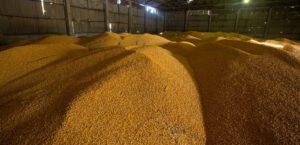
Ukraine in January this year reduced the export of titanium ores and concentrates in physical terms by 10.99 times compared to the same period last year – up to 2.066 thousand tons.
According to statistics released by the State Customs Service (SCS), exports of titanium ores and concentrates decreased 3.5 times in monetary terms – to $3.308 million.
At the same time, the main exports were shipped to Japan (72.22% in monetary terms), Egypt (13.94%) and Turkey (11.03%).
Ukraine in this period, as well as in January 2022, did not import these products.
As previously reported, in 2022, Ukraine reduced the export of titanium ore and concentrate in volume terms by 41.8% YoY – to 322.143 thousand tons, in monetary terms by 19.6% – to $130.144 million.
At the same time, the main export was carried out in the Czech Republic (47.91% in monetary terms), the U.S. (11.94%) and Romania (9.75%).
In 2022, Ukraine imported 196 tons of similar products from Senegal (70.41%) and Turkey (29.59%) for $115 thousand.
In Ukraine, the titaniferous ores are currently mined mainly at the United Mining and Chemical Company PJSC (UMCP), which controls Volnogorsk Mining and Metallurgical Works (VMMC, Dnepropetrovsk Region) and Irshansk Mining and Processing Works (IGOK, Zhitomir Region), as well as at Mezhdurechensk Mining and Processing LLC and Valki-Ilmenite LLC (both Irshansk, Zhitomir Region).
In addition, the production and commercial firm VELTA (Dnipro) has built a GOK at the Birzulovskoye deposit with a capacity of 240 thousand tons of ilmenite concentrate per year.

Ukraine in January this year reduced the export of semi-finished carbon steel products in physical terms by 92.1% compared to the same period last year – to 38,341 thousand tons.
According to statistics released by the State Customs Service (SCS), in monetary terms, exports of semi-finished carbon steel products in January 2022 declined by 93% – to $20.897 million.
The main export was carried out to Poland (54.20% of supplies in money terms), Denmark (24.91%) and Italy (11.31%).
In January-2023, Ukraine did not import any semi-finished products, whereas in January-2022 it imported 2.606 thousand tons of these products for $1.546 million. Imports were carried out from Russia (100% of supplies).
As reported, in 2022, Ukraine reduced the export of semifinished products of carbon steel in physical terms by 72% compared to the previous year – to 1 million 899.729 tons, in monetary terms by 70.9% – to $ 1 billion 191.279 million. The main export was carried out in Bulgaria (26.55% of supplies in monetary terms), Poland (13.97%) and Italy (12.13%).
In addition, Ukraine imported 5.558 thousand tons of similar products in 2022, which is 85.7% less than in 2021. In monetary terms, imports decreased by 86% – to $3.634 million. Imports were carried out from the Russian Federation (96.92% of supplies – before the war), China (1.84%) and Romania (1.21%).

Ukrainian companies in January this year, imports of copper and copper products in value terms decreased by 20.9% compared to the same period last year – up to $ 6.368 million.
According to customs statistics, released by the State Customs Service of Ukraine on Thursday, the export of copper and copper products for the period decreased by 56.2% – to $ 6.407 million.
In addition, Ukraine reduced imports of nickel and its products by 96.2% in January 2022 compared to January 2021 – to $312 thousand, aluminum and its products – by 33.6%, to $26.529 million. In addition, Ukraine reduced imports of lead and its products by 95.4% – to $32 thousand, imports of tin and its products by 20.4%, to $172 thousand, and zinc and zinc products – by 67%, to $2.238 million.
Exports of aluminum and aluminum products in the first month of 2023 fell 33.7% from January 2022 to $6.776 million, lead and lead products fell 41.4% to $1.633 million, and nickel and nickel products were $3,000, down from $397,000 in January 2022.
There were no zinc exports last month, whereas in January-2022 it was $220 thousand. Tin exports and products totaled $17 thousand in January-2023, whereas in January-2022 there were no.
As reported, Ukrainian enterprises in 2022 decreased imports of copper and copper products in value terms by 64.3% compared to the previous year – to $ 65.370 million, their exports decreased by 56.3% – to $ 90.245 million. In December-2022, imported copper and copper products for $ 6.107 million, exported – to $ 6.956 million.
In addition, Ukraine has reduced imports of nickel and its products by 49.9% in 2022 compared to 2021 – up to $59.754 million (in December – $0.668 million), aluminum and its products – by 33.4% to $340.398 million ($29.457 million). At the same time, the imports of lead and lead products decreased by 66.6% to $2.839 million ($12 thousand).
Imports of tin and tin products fell by 33.5% to $3.312 million ($171 thousand), while imports of zinc and zinc products decreased by 58.7% to $38.690 million ($4.386 million).
Exports of aluminum and aluminum products for 2022 decreased 42.7% from 2021 to $96.972 million ($6.330 million in December), lead and lead products decreased 68.7% to $11.970 million ($1.396 million), and nickel and nickel products decreased 73.9% to $1.268 million ($0.1 million).
Zinc exports for 2022 were $1.331 million ($11,000 in December) compared to $550,000 in 2021. Tin and products exports for 2022 were $424,000 ($1,000 in December) compared to $346,000 the previous year.

Ukraine exported in January “grain corridor” by 25% less agricultural products than in December due to deliberate actions of Russian inspectors to delay ships in the Bosphorus, the Administration of Sea Ports of Ukraine (AMPU) reported on Sunday.
According to the agency, in January the ports of “Big Odessa” processed 77 ships and sent 3 million tons of agricultural products to Africa, Asia and Europe, while in December the figure was 97 ships and 3.7 million tons of agricultural products, respectively.
At the same time, the Ministry of Infrastructure of Ukraine noted that the critically low rate of ships’ departure from the ports (2.5 ships per day) continues to remain. For comparison, in October this indicator was 5.7.
“In January, the ports worked only at 30-40% of capacity due to a shortage of the fleet to load. Three ships a day at the proposed nine are inspected in the Bosphorus and receive permission to move to Ukrainian ports for food,” – added in the ministry.
According to the ministry, the SKC plans to conduct 10 inspections a day, but Russian inspectors successfully complete only half of them.
“In January, 204 inspections were conducted, of which 173 were successful, another 31 inspections were not completed because Russian inspectors ended their workday prematurely and unilaterally at 3 p.m. 30 minutes (work time is regulated till 5:30 pm) or due to claims of documents not having been checked by the SKZ,” added the Ministry of Infrastructure.
In addition, the registration of vessels for participation in the initiative is also delayed. With more than 80 ships declared, the representatives of the aggressor country register 2-3 ships a day without any explanation. As of February 4, 120 vessels are waiting for inspection in Turkish territorial waters (98 – entering the ports for loading, 22 – with the agricultural products for the exit). The vast majority of them are waiting several weeks.
In total, for six months of operation of the “grain corridor” ports of Greater Odessa has sent 691 ships with 19.7 million tons of foodstuffs: the port of Chernomorsk – 285 ships-7.3 million tons, port “Odessa” – 215 ships-5.2 million tons and port “Pivdenny” – 191 ships with 6.6 million tons of food.
“The world received 19.7 million tons of food, and should receive more than 30 million tons, subject to the stable functioning of the corridor,” the department added.
As reported, in Istanbul on July 22 with the participation of the UN, Ukraine, Turkey and Russia signed two documents on the creation of a corridor for 120 days for the export of grain from the three Ukrainian ports – “Chernomorsk”, “Odessa” and “Pivdenniy”. After the end of its validity period, the agreement was extended for another 120 days, starting from November 19, 2022.

Ukraine exported 5.5 million tons of grain, oilseeds and their products in January, which is 1.3 million tons less than in December, the Ministry of Agrarian Policy reported on Saturday.
“Such a downward dynamic is due to the artificial blocking of the “grain corridor” by Russian inspectors,” the ministry said.
It specified that the “grain initiative” shipped only 3 million tons in the first month of the year, while previously the export of agricultural products in the corridor was 4 million tons or more per month.
According to the Ministry of Agrarian Policy, corn exports fell by 700 thousand tons – to 2.6 million tons, wheat – by 250 thousand tons, to 1.3 million tons.
A total of 15.4 million tons of corn and 9.7 million tons of wheat were exported in the marketing season (July 2022 – January 2023), while 39.2 million tons of oilseeds, the ministry said.
It added that during 11 months of war 44.4 million tons of agricultural products were sent from Ukraine to other countries, including 9.9 million tons of wheat and 18.2 million tons of corn. Insignificant difference in the supply of these crops compared to the new marketing season is associated with the closure of Ukrainian ports, which did not function for five months, and in August they began to gradually increase the volume, said the Ministry of Agrarian Policy.
According to his data, sunflower oil remained in the top three leading shipments in January with 347 tons, which is 121 thousand tons less than in December.
January shipments of soybeans declined slightly compared to December – to 345 tons from 387 tons, meal to 295 tons from 331 tons.
At the same time sunflower seed supply was reduced more than 1.6 times – to 190 thousand tons from 312 thousand tons more, and rapeseed – nearly 1.3 times: to 186 thousand tons from 237 thousand tons compared to 412 thousand tons in November.
As Ministry of Agricultural Policy noted, barley shipments remained almost unchanged in January: 168.7 tons against 179 tons in December. During the first month of 2023 soybean oil shipped by 6 thousand tons more – 26 thousand tons.
“The overall picture of January shipments as a percentage is as follows: corn – 47.36%, 24.23% – wheat, 6.33% – sunflower oil, soybeans – 6.29%, 5.38% – meal, sunflower seeds – 3.46%, canola – 3.39%, barley – 3.08%, soybean oil – 0.49%,” indicated the Ministry.
It added that the total volume of shipments for 11 months by crops: 18.2 million. MT – corn (40.88%), 9.9 million tons – wheat (22.25%), 3.6 million tons – sunflower oil (8.12%), 3.2 million tons – rape (7.21%), 2.9 million tons – sunflower seeds (6.49%), 2.5 million tons – meal (5.65%), 1.9 million tons – barley (4.21%), 2 million tons – soybeans (4.70%), 215 thousand tons – soybean oil (0.49%). tons – soybean oil (0.48%).
As reported, Ukraine in 2021/2022 MY exported 48.51 million tons of grain and leguminous crops, which is 8.4% higher than in the previous MY, despite the full-scale invasion of Russia and the difficulties with the export of agricultural products due to the blockade of Ukrainian seaports. 18.74 million tons of wheat (12.6% more than in 2020/2021MY), 23.54 million tons of corn (+1.9%), 5.75 million tons of barley (+35.9%), 70.9 thousand tons of flour (-44.1%) were supplied to foreign markets.
Ukraine in 2020/2021 MY exported 44.72 million tons of grain and leguminous crops: 16.64 million tons of wheat, 23.08 million tons of corn, 4.23 million tons of barley, 126.9 thousand tons of flour and 18.4 thousand tons of rye.
In 2019/2020, Ukraine exported a record 56.72 million tons of grain and leguminous crops.

Last year Ukraine exported agro-food products for the total sum of $23.4 billion, that is 16% less as compared to 2021.
According to an analysis by the Ukrainian Agrarian Export Association (UAEA), the figure was the second-largest since the country’s independence, despite the ongoing full-scale war unleashed by Russia against Ukraine in February 2022.
“The key issue for exporters in 2022 was to adapt to ensure all the necessary processes in the completely changed realities of the country’s agricultural sector. For value-added products, the situation managed to stabilize and keep under control, and some positions even showed growth,” the association specified in the document.
According to the Association, last year the total revenue from the export of meat and dairy products, potatoes, frozen vegetables increased, but the income of exporters decreased for the majority of varieties of fruits and vegetables, eggs, honey, processed grains and confectionery products. Meanwhile, export prices for Ukrainian goods, including honey and eggs, continued to rise.
UAEA specified that in 2022 Ukraine exported meat and by-products for $925 million (+9% in 2021), including poultry meat for $853 million (+19%), frozen beef for $69 million (-40%), ready and canned meat products for $21.8 million (2-fold growth) and sausages for $2.9 million (-58%). An important event of the last year was the reduction of quantitative volumes of exported poultry meat due to the war by 10%, to 413 thousand tons.
In turn, proceeds from the export of dairy products reached $251 million (+41% by 2021), including milk powder and condensed milk – $90 million (+57%), butter and milk paste – $82 million (+56%), cheese – $42 million (+58%), non-condensed milk and cream – $16 million (+58%), whey – $15 million (-31%). Ukrainian exports of ice cream exceeded $19 million (+5%), having decreased in real terms by 8%, to 6.9 thousand tons.
In addition, in 2022 exported 27 thousand tons of eggs (-32% to 2021) for $42 million (-7%) and 48 thousand tons of honey (-17%) for $137 million (-5%).
The UAE also noted a decrease in exports of all commodity items of fruits and vegetables, except for potatoes and frozen vegetables. Thus, 0.9 thousand tons of cucumbers (-82% vs. 2021) were sold abroad for $1.6 million (-72%), 1 thousand tons of cabbage for $0.9 million (-64%), 0.3 thousand tons of tomatoes (-94%). tons of tomatoes (-94%) by $0.8 million (-84%), 0.4 thousand tons of onions and garlic (-98%) by $0.3 million (-94%), 0.3 thousand tons of carrots and other root crops (-98%) by 0.2 million (-94%). At the same time, there was an increase in export sales of potatoes – up to 29.7 thousand tons (+56%) at $4.4 million (+14%) and frozen vegetables – 8.7 thousand tons (+3%) at $11 million (+15%).
Export of canned tomatoes also decreased more than three times – to 15 thousand tons, bringing $16 million in revenues. Prepared unfrozen vegetables were sold abroad for $9.7 million (-32%) in the amount of 4 thousand tons (-37%).
The organization estimated that the proceeds from the export of fruits, berries and nuts by the end of 2022 was $313 million (-15% to 2021), including the sale of 84 thousand tons of frozen fruits, berries and nuts. tons of frozen berries and fruits (+11%) for $192 million (-11%), 25 thousand tons of walnuts (-28%) for $80 million (-30%), 46 thousand tons of apples and pears (+56%) for $19 million (+28%), 4 thousand tons of berry crops for $14 million (+12%).
Export of jam, jelly and marmalade by Ukraine in monetary and physical terms remained at the level of 2012: over $ 7 million with the delivery of more than 2 thousand tons. The value of export of canned fruit and berry products decreased to $10 million (-48%), along with a decrease in sales – 3.8 thousand tons (-58%).
uaAE specified that Ukraine in 2022 exported 75 thousand tons of wheat flour (-29% in 2021) for about $24 million (-35%). The situation with sales abroad of pasta also worsened – down to 18 thousand tons (-54%), sold for $40 million (-45%).
“Sales of confectionery sugar products to foreign markets decreased to $139 million (-32%) for 70 thousand tons (-31%). Exports of cocoa products and chocolate amounted to $147 million (-34%) in the amount of 46 thousand tons (-35%). There was also a decrease in foreign sales of bakery confectionery – to 69 thousand tons (-39%) worth $152 million (- 40%),” summed up the association.